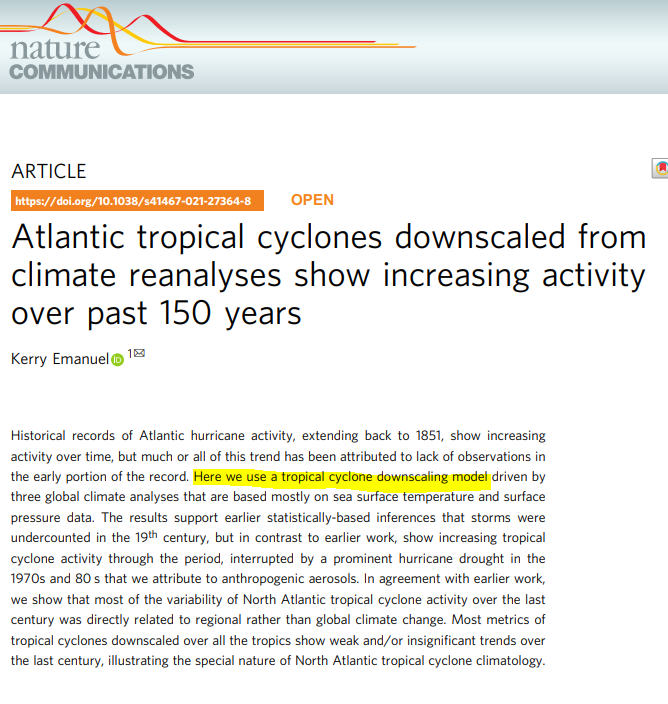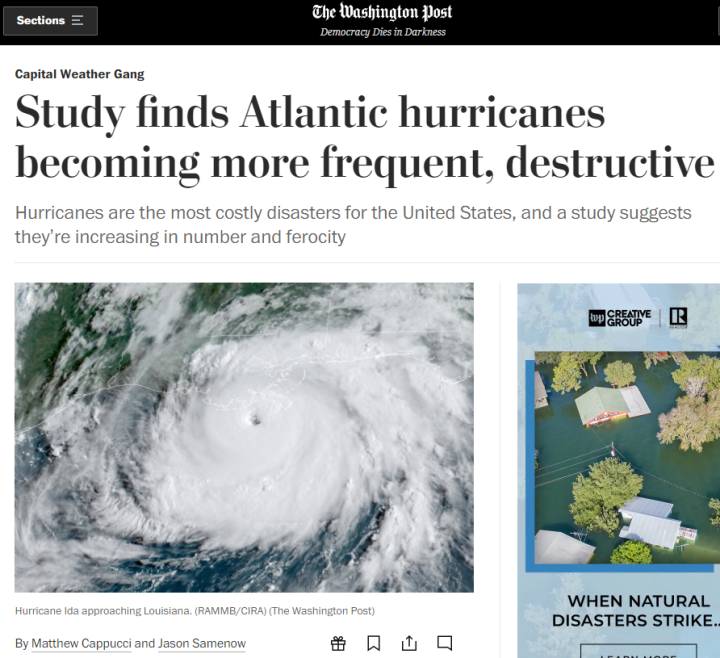Pielke Jr. Slams Kerry Emanuel’s Latest
Absolutely amazing & somewhat sad
Observations of hurricane activity apparently don’t show the right trends.
So this new paper re-invents history by using modeled historical hurricane activity to find the right trends.
Predictably, gross misinformation follows
This is where we are at in hurricane research?😐
And the MIT press release fails to accurately reflect the paper
Irresponsible
It goes undisclosed that the author runs a consulting firm that sells modelled hurricane projections under RCP8.5
Bottom line⬇️
Originally tweeted by Roger Pielke Jr. (@RogerPielkeJr) on December 2, 2021.
Here is EurekAlert!’s release on the study.
Climate modeling confirms historical records showing rise in hurricane activity
New results show North Atlantic hurricanes have increased in frequency over the last 150 years.
MASSACHUSETTS INSTITUTE OF TECHNOLOGY
When forecasting how storms may change in the future, it helps to know something about their past. Judging from historical records dating back to the 1850s, hurricanes in the North Atlantic have become more frequent over the last 150 years.
However, scientists have questioned whether this upward trend is a reflection of reality, or simply an artifact of lopsided record-keeping. If 19th-century storm trackers had access to 21st-century technology, would they have recorded more storms? This inherent uncertainty has kept scientists from relying on storm records, and the patterns within them, for clues to how climate influences storms.
A new MIT study published today in Nature Communications has used climate modeling, rather than storm records, to reconstruct the history of hurricanes and tropical cyclones around the world. The study finds that North Atlantic hurricanes have indeed increased in frequency over the last 150 years, similar to what historical records have shown.
In particular, major hurricanes, and hurricanes in general, are more frequent today than in the past. And those that make landfall appear have grown more powerful, carrying more destructive potential.
Curiously, while the North Atlantic has seen an overall increase in storm activity, the same trend was not observed in the rest of the world. The study found that the frequency of tropical cyclones globally has not changed significantly in the last 150 years.
“The evidence does point, as the original historical record did, to long-term increases in North Atlantic hurricane activity, but no significant changes in global hurricane activity,” says study author Kerry Emanuel, the Cecil and Ida Green Professor of Atmospheric Science in MIT’s Department of Earth, Atmospheric, and Planetary Sciences. “It certainly will change the interpretation of climate’s effects on hurricanes — that it’s really the regionality of the climate, and that something happened to the North Atlantic that’s different from the rest of the globe. It may have been caused by global warming, which is not necessarily globally uniform.”
Chance encounters
The most comprehensive record of tropical cyclones is compiled in a database known as the International Best Track Archive for Climate Stewardship (IBTrACS). This historical record includes modern measurements from satellites and aircraft that date back to the 1940s. The database’s older records are based on reports from ships and islands that happened to be in a storm’s path. These earlier records date back to 1851, and overall the database shows an increase in North Atlantic storm activity over the last 150 years.
“Nobody disagrees that that’s what the historical record shows,” Emanuel says. “On the other hand, most sensible people don’t really trust the historical record that far back in time.”
Recently, scientists have used a statistical approach to identify storms that the historical record may have missed. To do so, they consulted all the digitally reconstructed shipping routes in the Atlantic over the last 150 years and mapped these routes over modern-day hurricane tracks. They then estimated the chance that a ship would encounter or entirely miss a hurricane’s presence. This analysis found a significant number of early storms were likely missed in the historical record. Accounting for these missed storms, they concluded that there was a chance that storm activity had not changed over the last 150 years.
But Emanuel points out that hurricane paths in the 19th century may have looked different from today’s tracks. What’s more, the scientists may have missed key shipping routes in their analysis, as older routes have not yet been digitized.
“All we know is, if there had been a change (in storm activity), it would not have been detectable, using digitized ship records,” Emanuel says “So I thought, there’s an opportunity to do better, by not using historical data at all.”
Seeding storms
Instead, he estimated past hurricane activity using dynamical downscaling — a technique that his group developed and has applied over the last 15 years to study climate’s effect on hurricanes. The technique starts with a coarse global climate simulation and embeds within this model a finer-resolution model that simulates features as small as hurricanes. The combined models are then fed with real-world measurements of atmospheric and ocean conditions. Emanuel then scatters the realistic simulation with hurricane “seeds” and runs the simulation forward in time to see which seeds bloom into full-blown storms.
For the new study, Emanuel embedded a hurricane model into a climate “reanalysis” — a type of climate model that combines observations from the past with climate simulations to generate accurate reconstructions of past weather patterns and climate conditions. He used a particular subset of climate reanalyses that only accounts for observations collected from the surface — for instance from ships, which have recorded weather conditions and sea surface temperatures consistently since the 1850s, as opposed to from satellites, which only began systematic monitoring in the 1970s.
“We chose to use this approach to avoid any artificial trends brought about by the introduction of progressively different observations,” Emanuel explains.
He ran an embedded hurricane model on three different climate reanalyses, simulating tropical cyclones around the world over the past 150 years. Across all three models, he observed “unequivocal increases” in North Atlantic hurricane activity.
“There’s been this quite large increase in activity in the Atlantic since the mid-19th century, which I didn’t expect to see,” Emanuel says.
Within this overall rise in storm activity, he also observed a “hurricane drought” — a period during the 1970s and 80s when the number of yearly hurricanes momentarily dropped. This pause in storm activity can also be seen in historical records, and Emanuel’s group proposes a cause: sulfate aerosols, which were byproducts of fossil fuel combustion, likely set off a cascade of climate effects that cooled the North Atlantic and temporarily suppressed hurricane formation.
“The general trend over the last 150 years was increasing storm activity, interrupted by this hurricane drought,” Emanuel notes. “And at this point, we’re more confident of why there was a hurricane drought than why there is an ongoing, long-term increase in activity that began in the 19th century. That is still a mystery, and it bears on the question of how global warming might affect future Atlantic hurricanes.”
This research was supported, in part, by the National Science Foundation.
###
Written by Jennifer Chu, MIT News Office
JOURNAL
Nature Communications
ARTICLE TITLE
Atlantic tropical cyclones downscaled from climate reanalyses show increasing activity over past 150 years










